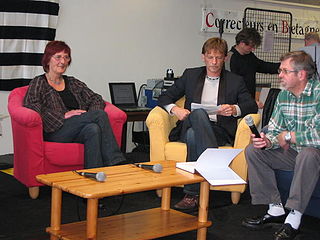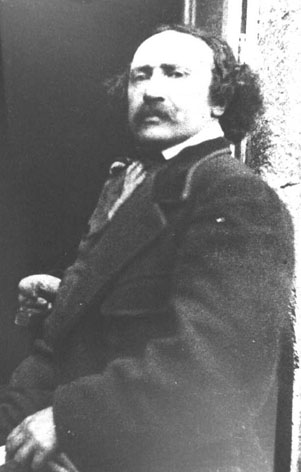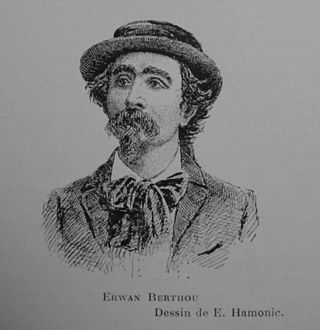Since the early 1970s, Brittany has experienced a tremendous revival of its folk music. Along with flourishing traditional forms such as the bombard-biniou pair and fest-noz ensembles incorporating other additional instruments, it has also branched out into numerous subgenres.

Breton literature may refer to literature in the Breton language (Brezhoneg) or the broader literary tradition of Brittany in the three other main languages of the area, namely, Latin, Gallo and French – all of which have had strong mutual linguistic and cultural influences.
Radio Rennes Bretagne was a radio station based in Rennes, and the first station to have regular Breton language programming. However, it was not powerful enough to broadcast to the Breton-speaking western parts of the peninsular. From November 1940 to June 1944 the station broadcast bilingual programming by switching over to Radio Paris for one hour each week.

Seiz Breur was an artistic movement founded in 1923 in Brittany. Although it adopted the symbolic name seiz breur, meaning seven brothers in the Breton language, this did not refer to the number of members, but to the title of a folk-story. At its height it had fifty members united as the "Unvaniezh Seiz Breur".

Before and during World War II, the various Breton nationalist movements were generally right-wing, and sometimes fascist. The extent to which this led to collaboration with the Nazi occupiers of France during the war, together with their motivations, is a matter of historical controversy.

Yves Lainé is a Breton lawyer, politician and companies executive manager, now a writer, arguing for the return of Loire-Atlantique departement in the administrative région of Brittany the reunification and devolution of the historical Brittany.

François-Marie Luzel, often known by his Breton name Fañch an Uhel, was a French folklorist and Breton-language poet.

The Breton regionalist union was a Breton cultural and political organisation created August 16, 1898. It was a broadly conservative grouping dedicated to preserving Breton cultural identity and regional independence. It expressed the ideology of mainly middle-class and aristocratic groups to secure continuity in local administration and Breton culture.

François Debeauvais was a Breton nationalist and wartime collaborator with Nazi Germany. His name is also spelled in many "Breton" variants: François Debauvais, Fransez Debeauvais, Fransez Debauvais, Fañch Debeauvais, Fañch Debauvais, Fañch deb.

Yann-Fañch Loeiz Kemener was a traditional singer and ethnomusicologist from Brittany, born in Sainte-Tréphine, Côtes-d'Armor, France. Known in French as Jean-François Louis Quémener.

Erwan Berthou was a French and Breton language poet, writer and neo-Druidic bard. His name is also spelled Erwan Bertou and Yves Berthou.
Jean Le Fustec was a Breton bard, and the first Archdruid of the Goursez Vreizh. He is also known by his Breton language name Yann ab Gwilherm and his Druidic name Lemenik.
Erwan is a masculine Breton given name, sometimes spelled Erwann. Its francization is the French given name Yves.

Annie Ebrel is a traditional Breton singer of traditional Kan ha diskan and Gwerz (ballads).

The Festival de Cornouaille is an annual festival taking place in Quimper, a city in the south-west of Brittany, a western region of France. The festival begins on the third Sunday of July and lasts for one week. It has been held since 1923 and is one of the biggest cultural events in Brittany.
Al Liamm is a bimonthly magazine of culture and literature in the Breton language.
The Order of the Ermine was originally a chivalric order of the 14th and 15th centuries in the Duchy of Brittany. The ermine is the emblem of Brittany. In the 20th century, it was revived by the Cultural Institute of Brittany as an honor for those contributing to Breton culture. It was created in 1972 to honor those who contribute to Breton culture and development. At its head is a Chancellor and two vice-chancellors: Riwanon Kervella and André Lavanant. The siege is at the Institut Culturel de Bretagne, the castle of the Ermine, Vannes.
"Gwerz Skolan" is a gwerz with a long tradition in Lower Brittany, especially Léon-Trégor and Cornouaille. Its story is found in Old Welsh texts also, and the oldest extant Welsh version is found in the 13th-century Black Book of Carmarthen. The poem is cited as evidence for the preservation in Brittany of cultural memories and traditions predating the entrance of Bretons into Brittany. The gwerz was performed in Brittany until the 19th century, with some late examples from the 20th century. Its content describes a man who had died after living a life of rape and murder, and now comes back from hell to ask for forgiveness.
Jean-Louis ar Rolland was a Breton writer, notable for having remembered, and then written down, the stories he had been told during his childhood and after, traditional oral tales in the poetic gwerz tradition. Two of his collections were published, in Breton; he is hailed as one of the last of the Breton singers of traditional poetry.